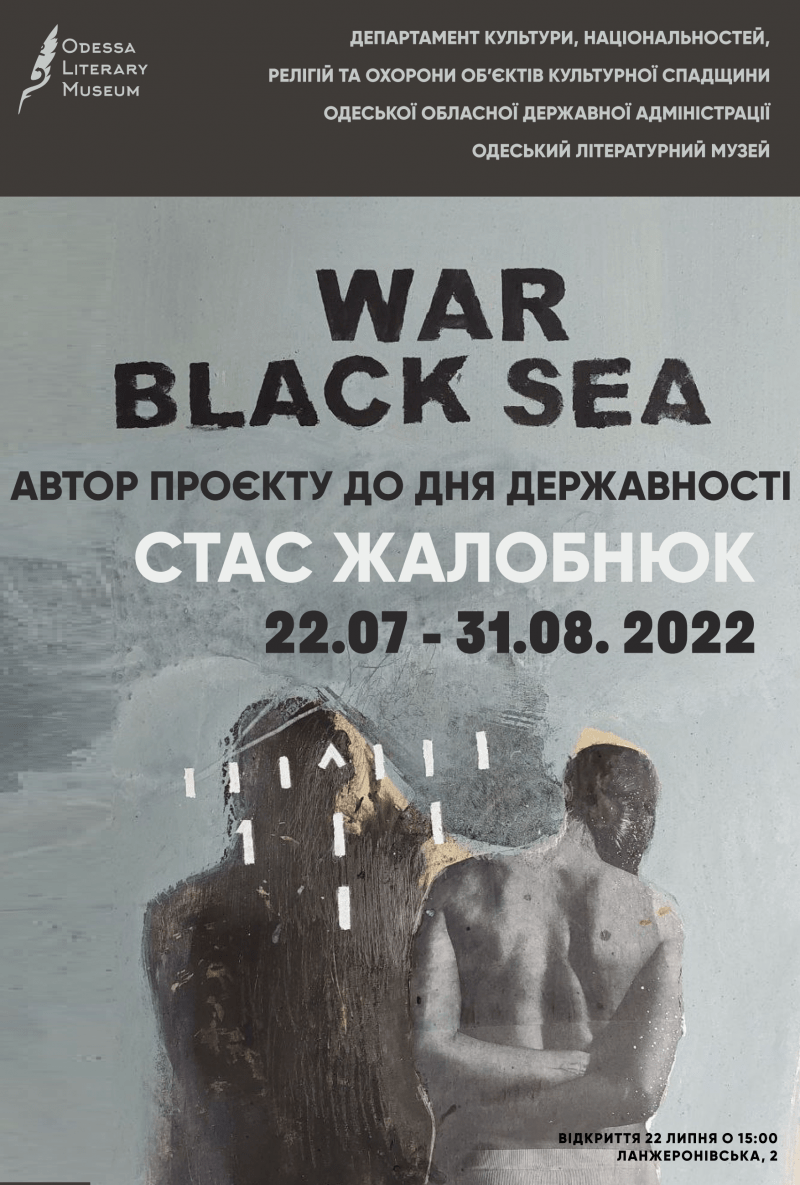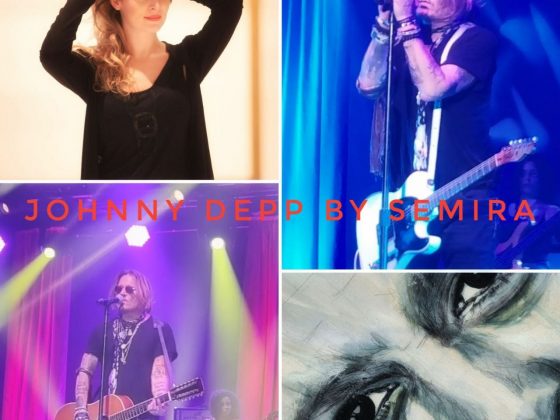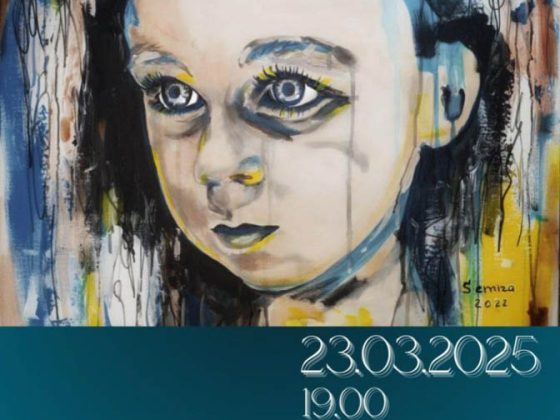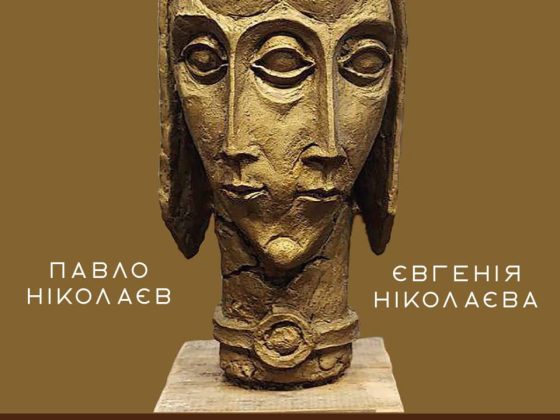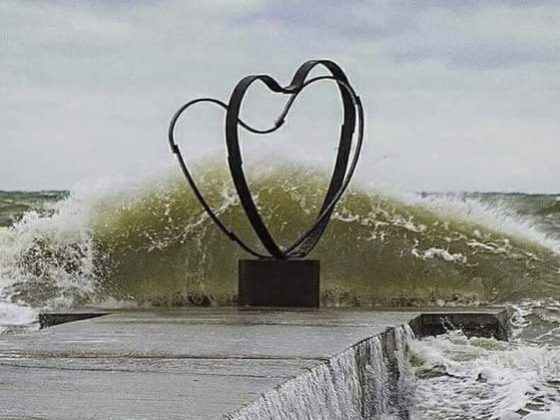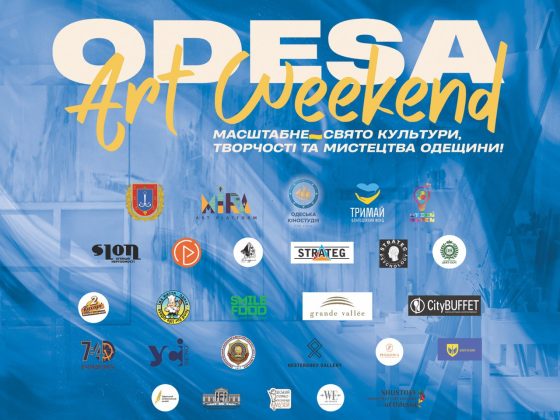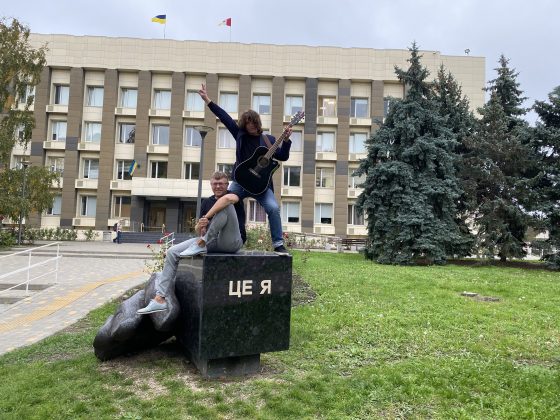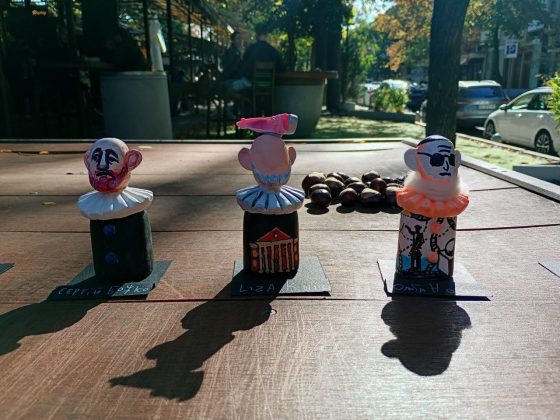Stas Zhalobnyuk managed to make a clear statement at once. His first personal exhibition has indicated his considerable artistic abilities and skills: that was a big exposition in a large Maritime Art Gallery located directly in Odesa Sea Port. That event reflected the fact that a real artist has appeared in Odesa.
In fact, “Radiation” is not an exhibition, but a project. A real project which consists of four parts, four themes, united by one – and that is war. The real WAR! In the 21st century! Wild and horrible, near our Black Sea, the Black Sea War. A question arises: what can or may an artist do during the war, especially a new kind of war, a non-contact warfare? It means that a soldier sees the target in the thermal monocular, observing it in a long distance. Hmm, than the buildings and people appear to be some schematic pictures; people are seen on a screen like some kind of “radiation” thanks to their “warmth”.
Stas Zhalobniuk is a real ARTIST at his core, a well-known painter, who took part in all-Ukrainian exhibitions in Ivano-Frankivsk, Khmelnytskyi, Lviv, Kharkiv, Kyiv and other cities. He has created his own statement which helps him stand out from other famous artists. He has exhibited his works abroad before. Twice he had exhibited his works in Kiev International Convention Center, “Ukrainian House”, on Khreshchatyk Street, significant at that time, and these were the PROJECTS, not just display of paintings! They were EXPRESSIONS of inner feelings, not just canvases, looking more like installations.
So, Stas Zhalobniuk HAS a NAME! That’s why his exhibits by definition arouse the interest, because there is an IDEA and his own opinion.
As a person who is going through everything deeply, the painter even suffers that the artist practically cannot change the situation… or maybe he can? And although he admits, that in the idea of an art that can change something there is something unreal, even pathological… , he still can influence, because he works not with the text, but with the pictures, images, which, as is known, penetrate deeper into the human‘s gut and live there longer. Moreover, they can “sprout”. He perceives his location in the world like Odysseus from Illyade, who has chosen this place as his own, and that’s why it hurts him. Due to this, on his own portrait he holds his tilted head, but there is already a telescopic sight at it! These sights are present in the majority of his paintings.
These are the paintings (acrylic paint, oil), but on the carton of rather huge size. There is some kind of sameness, like in a computer game. How come, that such a super class painter abandoned own mastery and turned to a sort of sketchiness? Stas explains: “I don’t understand how is it – “not to worry”, because I really am a nervous person, not just “an artist”, I can’t conceal my feelings. To be a person who tries to hide them – is “to lie” for me. In addition, “beautiful” senses, meanings and images do not work during these times. I agree, the coloristics is rather monotonous, but the telescopic sights make the canvases even more mechanistic. Like everything takes place inside the computer game: you aim, you destoy, and so on, and on… “
Brown colours are dominant in the triptych named INDUSTRIAL ZONE, as a sign of the broken remains of tanks as well as the production machines.
As for the grey colour, which is dominant in the series about our BLACK SEA, there are dangers included. Both – natural, because of the presence of hydrogen sulfide, and artificial, because of the submarines and huge naval mines.
Short inscriptions tend to direct the observer’s view, but “T” – is a sign of optical sight everywhere. It is targeted on everything. Especially, when on people…, you are seen, when you are alive, because “warm” = “alive”. This is a non-contact warfare of the 21st century… Here is where the theme of “maimed and horrible disfigured body” came from, where you are no longer personality, but just a body.
No, there isn’t any reference to porno, but to the tortures – “distortion”.
The author is trying to explain that he has regected the real coloristics, because in his opinion, it interrupts the coming of consciousness of what happens here in Ukraine. It is presented in the “intestinal”, almost anatomical, works, where orange is dominating. “Yes”, the artist acknowledges, “the bodies torn into pieces are unsuited to the interior, one cannot decorate his life with.”
Then we are approaching to the topic of bread, because bread, on the author’s opinion, is the equivalent to the body, “since Ukraine is the breadbasket, and when they steal or destroy the grain, they steal the body.” Notice the Ukrainian word “zhyty” – to live – “zhytnytsia” – the granary – “zhyttia” – the life. Then the involvement of the BREAD theme becomes more understandable. By the way, about the active fighting near our salt mines in Soledar: the enemy wipes out one of the Ukrainian oldest traditions to enter the house or to meet guests necessarily with bread and SALT.
Almost annoying are the captions in the paintings with the outright curses addressing the russians, extremely candid, but maybe they should be like this?!
Ute Kilter
ВИПРОМІНЮВАННЯ з ЧОРНОГО МОРЯ від СТАСА ЖАЛОБНЮКА
Стасу Жалобнюку вдалося одразу заявити про себе, голосно та виразно. Вже його перша персональна виставка свідчила про неабиякий художній хист та вміння: то була велика експозиція у приміщенні також великої за розміром «Морської галереї» (безпосередньо в Одеському порту). Та виставка свідчила: у місті Одесі з’явився справжній майстер.
Насправді, «Випромінювання» – то не виставка, а проєкт. Справжній, бо має чотири складові, чотири теми, які по суті об’єднані однією, – і то війна. Справжня ВІЙНА! У ХХІ сторіччі! Дика та страшна, ще й поблизу нашого Чорного моря, the Вlack Sea War. Виникає питання: що має чи може робити творець під час війни, тим більш війни новітньої, яка є «безконтактною»? Тобто солдат лише бачить у тепловізор, здалеку, свою ціль. Хм, тоді будинки і люди виявляються якимись схематичними зображеннями; хоча люди, завдяки своїй «теплоті» у приймачі виявляються як деяке «випромінювання».
Треба зазначити, що Стас Жалобнюк за суттю своєю є справжнім ХУДОЖНИКОМ, більш того, відомим живописцем, який приймав участь у всеукраїнських виставках в Івано-Франківську, Хмельницькому, Львові, Харкові, Києві та інших містах. Він здатен створити власне висловлювання, яке й виокремило його з широкого загалу відомих митців. Зрозуміло, що мав виставки й за кордоном.
А потім, на підтвердження, ще й двічі у значущому на той час «Українському домі» у Києві, на Хрещатику, де в нього вже тоді були ПРОЄКТИ, а не просто виставляння творів живопису! Вони ставали ВИСЛОВЛЮВАННЯМИ, до того ж включали в себе багато чого окрім полотен, тяжіли до справжніх інсталяцій.
Тобто Стас Жалобнюк МАЄ ім’я! Тому його виставки напевне викликають зацікавленість, бо там присутня ІДЕЯ та його власна думка. Як людина, що здатна переживати глибоко, художник навіть страждає, через те, що митець фактично не може кардинально змінити ситуацію… чи все ж таки на щось здатен? І хоча визнає, що в ідеї про мистецтво, яке здатне щось змінити, є щось нереальне, навіть патологічне…, все ж впливати може, бо «працює» не текстуально, а «картинками», образами, які, як відомо, проникають глибше у людське нутро й живуть там довше. Більш того, здатні «проростати».
Він сприймає своє місцеположення у світі наче Одисей з Іліади, що вибрав це місце як «своє», тому «йому болить». Через це на його власному зображенні він тримається за похилену голову, але там вже є ПРИЦІЛ!
Ці приціли також присутні на більшості його картин.
Це живопис (акрил, олія), але на картоні, досить значного розміру, там присутня якась одноманітність, начебто у якійсь комп’ютерній грі. Як так, що живописець супер класу відмовився від власної майстерності та перейшов до подібного схематизму? Стас пояснює: «Не розумію, як це – «не хвилюватися», адже я дійсно є знервованою людиною, а не просто там «митцем», мені не вдається приховувати свої переживання. Бути людиною, що намагається їх приховати, – це брехати. До того ж «красиві» сенси, зображення не працюють в цей час. Визнаю, колористика доволі одноманітна, але ПРИЦІЛ робить полотна ще більш механістичними. Наче все відбувається у комп’ютерній грі: прицілився і знищив, далі те саме…»
У триптиху ПРОМЗОНА домінує коричневе, як залишки знищених танків, але й також станків виробництв.
Щодо домінування сірого у зображенні нашого ЧОРНОГО МОРЯ, то там закладена й небезпека. Як природня, бо у нас присутній сірководень, так і від підводних човнів і круглих, величезних мін.
Короткі написи начебто спрямовують глядача, але «Т» – то приціл, усюди. Він спрямований на геть усе. Особливо якщо на людину, – тебе бачуть, бо коли ти теплий = живий. Це безконтактна війна ХХІ сторіччя… Звідки й пішла тема «пошматованого, викрученого тіла», де ти не є особистістю, а лише тілом. Ні, там не натяк на порно, але на тортури – «викрученість».
Автор намагається пояснити, що відмовився від справжньої колористики, бо на його думку, вона заважає «ПРОБИТИСЯ» до усвідомлення усього цього, що тут, в Україні, відбувається. Вона присутня у «кишкових», практично анатомічних роботах, де домінує помаранчевий колір.
«Так, – підтверджує художник, – пошматоване тіло неприcтосоване для інтер’єру, цим не можна прикрасити житло/життя».
Звідти перехід до теми хліба, бо хліб, на думку автора, дорівнює тілу, «бо Україна є житницею, і коли крадуть чи знищують хліб, то крадуть тіло». Зверніть увагу на українське «жити» – житниця – життя. Тоді стає ще більш зрозумілим залучення теми ХЛІБА. До речі, активні бойові дії біля наших соляних копалень в Соледарі: ворог знищує нашу українську традицію заходити у чийсь дім обов’язково з хлібом та СІЛЛЮ, або радо зустрічати = «з хлібом та сіллю».
Майже дратують вписані у живопис відкриті прокляття на адресу росіян, надто вже відверто, але, можливо, так і треба?!
Особливо після знайомства з циклом STOP GENOCIDE…
Ute Kilter

